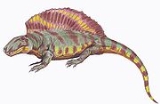
Sphenacodontoidea
Encyclopedia
Sphenacodontoidea is the name given to the clade
that includes the most recent common ancestor
of the Sphenacodontidae
and the Therapsida and their descendants (including mammals). They are defined according to a number of specialised characteristics
concerning proportions of the bones of the skull and the teeth.
The Sphenacodontoidea evolved from earlier Sphenacodontia
such as Haptodus
via a number of transitional stages of small, unspecialised pelycosaur
s.
Clade
A clade is a group consisting of a species and all its descendants. In the terms of biological systematics, a clade is a single "branch" on the "tree of life". The idea that such a "natural group" of organisms should be grouped together and given a taxonomic name is central to biological...
that includes the most recent common ancestor
Most recent common ancestor
In genetics, the most recent common ancestor of any set of organisms is the most recent individual from which all organisms in the group are directly descended...
of the Sphenacodontidae
Sphenacodontidae
Sphenacodontidae is a family of small to large, advanced, carnivorous, Late Pennsylvanian to middle Permian pelycosaurs. Primitive forms were generally small in size , but during the later part of the early Permian these animals grew progressively larger , to become the top predators of their...
and the Therapsida and their descendants (including mammals). They are defined according to a number of specialised characteristics
Synapomorphy
In cladistics, a synapomorphy or synapomorphic character is a trait that is shared by two or more taxa and their most recent common ancestor, whose ancestor in turn does not possess the trait. A synapomorphy is thus an apomorphy visible in multiple taxa, where the trait in question originates in...
concerning proportions of the bones of the skull and the teeth.
The Sphenacodontoidea evolved from earlier Sphenacodontia
Sphenacodontia
Sphenacodontia is the name given to the clade that includes the Sphenacodontidae and all their descendants . They first appear during the Late Pennsylvanian epoch. The defining characteristics include a thickening of the maxilla visible on its internal surface, above the large front teeth; and...
such as Haptodus
Haptodus
Haptodus was a small sphenacodont, a clade that includes therapsids and hence, mammals. It was at least in length. It lived from Latest Carboniferous to Early Permian, in the equatorial Pangea. It was a medium-sized predator, feeding on insects and small vertebrates. It is one of the basalmost...
via a number of transitional stages of small, unspecialised pelycosaur
Pelycosaur
The pelycosaurs are an informal grouping composed of basal or primitive Late Paleozoic synapsid amniotes. Some species were quite large and could grow up to 3 meters or more, although most species were much smaller...
s.
Taxonomy and Phylogeny
- Suborder EupelycosauriaEupelycosauriaThe Eupelycosauria originally referred to a suborder of 'pelycosaurs' , but has been redefined to designate a clade of synapsids that includes most pelycosaurs, as well as all therapsids and mammals...
- SphenacodontiaSphenacodontiaSphenacodontia is the name given to the clade that includes the Sphenacodontidae and all their descendants . They first appear during the Late Pennsylvanian epoch. The defining characteristics include a thickening of the maxilla visible on its internal surface, above the large front teeth; and...
- Sphenacodontoidea
- Family †SphenacodontidaeSphenacodontidaeSphenacodontidae is a family of small to large, advanced, carnivorous, Late Pennsylvanian to middle Permian pelycosaurs. Primitive forms were generally small in size , but during the later part of the early Permian these animals grew progressively larger , to become the top predators of their...
- †CtenorhachisCtenorhachisCtenorhachis is an extinct genus of the family Sphenacodontidae. Ctenorhachis was related to Dimetrodon, but did not belong to the same subfamily as Dimetrodon and Sphenacodon, being a more basal member of Sphenacodontidae. Ctenorhachis lived in the Early Permian epoch...
- †CtenospondylusCtenospondylusCtenospondylus, was a pelycosaur that was about 3 meters long. It lived from Latest Carboniferous to Early Permian. Its fossils were found in the U.S. states of Ohio and Texas. It was a carnivore and preyed upon animals close to its size...
- †DimetrodonDimetrodonDimetrodon was a predatory synapsid genus that flourished during the Permian period, living between 280–265 million years ago ....
- †NeosaurusNeosaurusNeosaurus is a little-known pelycosaur of the family Sphenacodontidae. It was related to the well known Dimetrodon, although much smaller and lived during the Early Permian. Its fossils were found in the Jura region of France....
- †SecodontosaurusSecodontosaurusSecodontosaurus was a pelycosaur that lived in Texas during the Early Permian age. Though it had the same body style as other sphenacodontids, it had an unusually low and narrow skull. It had a long neural spines, like Dimetrodon, which Secodontosaurus was related to...
- †SphenacodonSphenacodonSphenacodon was a pelycosaur that was about in length. Sphenacodon belongs to the family Sphenacodontidae, a lineage that was related to the therapsids...
- †SteppesaurusSteppesaurusSteppesaurus is an extinct genus of pelycosaur belonging to the Sphenacodontidae family, related to Dimetrodon and Sphenacodon....
- †Ctenorhachis
- †TetraceratopsTetraceratopsTetraceratops insignis was a lizard-like synapsid. It lived during the Early Permian period. According to a recent, controversial report, T. insignis is the first known therapsid. Other scientists, on the other hand, say that it is a more primitive species of synapsid, possibly an unusual,...
- ORDER THERAPSIDA
- ORDER THERAPSIDA
- Family †Sphenacodontidae
- Sphenacodontoidea
- Sphenacodontia

